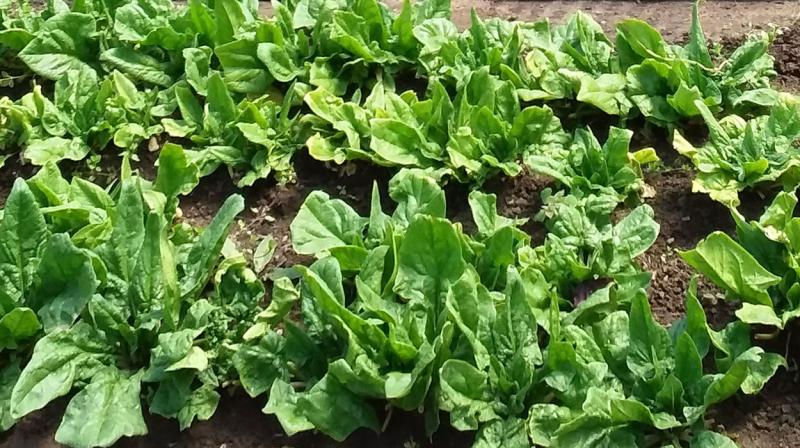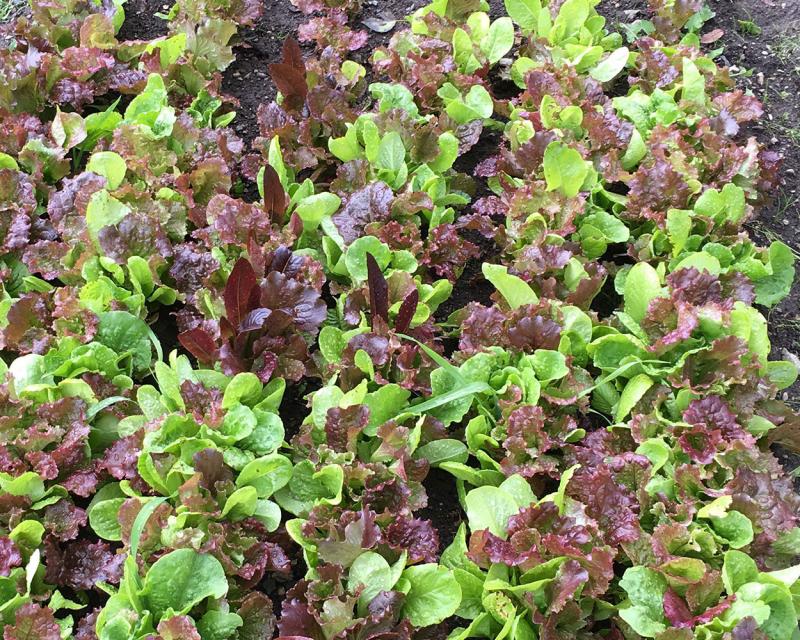Written by Rhoda Burrows, former Professor & SDSU Extension Horticulture Specialist.
Description

General Description: Salad greens, grown for their leaves, are cool-season crops. Included here are various kinds of lettuce and spinach, as well as greens with spicy or strong flavors (arugula and Asian greens, such as tatsoi, mizuna, etc.).
Most salad greens can be planted very early in the spring. Many will germinate in soil temperatures as low as 40°F, although they will emerge much more rapidly at warmer temperatures (up to 70°F). Salad greens grow best during cool weather. Hot temperatures can cause them to become bitter or “bolt” (send up a flowering stalk). If you want to grow them during the hot months of July and August, look for “heat-tolerant” varieties and plant them where they will receive afternoon shade. Salad greens do well in containers, as long as the soil is not allowed to dry out.
Types

- Lettuce: Loose-leaf types are harvested as individual leaves. These tend to be somewhat softer and can range from green to various shades of red or bronze leaves (Figure 2). Heading types include Butterhead, Bibb, and Romaine types, with loose heads. The common “Iceberg” type sold in grocery stores requires a long, cool season, so it is not recommended for South Dakota.
- Spinach: Both smooth-leaved and crinkled-leave types are available. Smooth-types are better for fresh eating and crinkled-types are better for cooking. Spinach will bolt easily under high temperatures and long days, so it is commonly grown as a spring or fall crop. It is very cold-hardy, and it is able to withstand temperatures down to 20°F without acclimation. Some varieties can even survive 1°F if they are gradually exposed to cold temperatures!
- Mustard (Brassica) family greens: Arugula, also known as Rocket or Roquette, has a spicy taste with a nutty undertone. It can be used raw or cooked; both leaves and flowers can be used. It will bolt very quickly in warm weather. Corn salad or mâche, Tatsoi, and mizuna are early-season greens that will be sweeter and more tender with cooler nights.
Planting

Timeline: Sow seed from early spring through midsummer into moist soil in full sun to part-shade (Figure 3). Days to germination range from 2-to-10 depending on type and soil temperature. Soil temperatures above 80°F or above can inhibit germination. Thus, during the warmer summer months, germinating the seed indoors and transplanting may be necessary. Days to harvest range from 26 (baby leaves) to 80 (full-sized romaine heads).
Sowing:
- Lettuce: Sow every 2-to-3 weeks for a continuous supply of either heads or salad mix.
- Spinach and Arugula: Sow 15 seeds-per-foot, ¼-inch deep in 2-inch-wide bands in rows 18 inches apart.
- Baby Leaf Spinach or Lettuce: Sow 4-to-6 seeds-per-inch in rows at least 2 inches apart, or in bands with approximately 60 seeds per square-foot. Cover lightly to 1/8 inches and firm gently. Dry soil must be watered to ensure coolness, moisture and uniformity.
- Head Lettuce Transplants: Start seed 3-to-4 weeks before transplanting. Sow seed and barely cover with vermiculite, or fine soil. Keep at cooler room temperatures (below 75°F during germination). Young plants properly hardened off (by gradually exposing them to outdoor conditions) at least 3-to-5 days before planting can survive temperatures as low as 20°F. Transplant romaine and butterhead lettuce 10-to-12 inches apart in rows 15-to-18 inches apart. Other types should be planted 8-to-10 inches apart in rows 12-to-18 inches, and mini heads as close as 6 inches in a grid.
- Other Greens: Sow every two weeks until early summer. Most will be ready to harvest in 4-to-6 weeks.
Late Planting: If given winter protection, such as straw mulch or multiple layers of row covers, some of the hardier greens, such as spinach, may be planted in late summer or early fall and survive the winter for an early spring harvest. If you want to try this, the plants should be 1-to-3 inches high by the time winter sets in, which means planting around six weeks earlier (Given our unpredictable fall weather, you may want to try a couple of planting dates). Cover once the soil temperatures near freezing. This will protect the plants and also keep them from losing hardiness on warm days. Uncover once temperatures warm in the spring and the surrounding soils thaw.
Plant Care
Watering: Salad greens require moist, but not soggy soil. Young plants will be shallowly rooted and should be watered once the top half-to-one-inch of soil dries out.
Weeding/Mulching: Mulch can be helpful in decreasing weed problems. Be careful that your mulch application does not keep the crowns of the plants constantly moist, as it can lead to plant diseases.
Fertilizing: A plentiful supply of nitrogen will keep the leaves tender and sweet. Compost or well-rotted manure (a year or more old) can help supply nutrients and retain soil water. Additional nitrogen can be added through the season, especially if older leaves start to turn lighter green or yellow. For a fertilizer containing 15% nitrogen (Calcium nitrate, for example, has a ratio of 15-0-0, or 15% nitrogen), spread 1 Tablespoon over each two feet of row. If using lawn fertilizer (34-0-0 make certain it is straight fertilizer, without weed killer), you would spread 1 Tablespoon over 4-to-5 feet of row after a few weeks of growth, or when you see yellowing leaves. Arugula and Asian greens need less nitrogen than lettuce or spinach.
Pest and Diseases

Major Pests:
- Flea Beetles: Flea beetles are a major pest of Arugula (Figure 4). They can be controlled by covering the crop with floating row covers from the day of sowing.
Major Diseases:
- Salad crops in South Dakota generally do not have many disease problems.
- Foliage rots, including downy mildew, can be an occasional problem in hot, wet conditions.
- It is always a good idea to reduce potential diseases with crop rotation and sanitation.
Minor Problems:
- Bitter leaves can occur when plants become stressed by drought or heat, or if they are simply too mature.
- Make repeated plantings through the spring to keep young plants available.
Harvest
Baby Lettuce or Spinach: Clip young leaves when 3-to-6 inches-tall, or harvest outer leaves. For heading lettuce, such as butterheads, cut the whole head at the desired size, but before the inner leaves begin to turn yellow. If cut about an inch above the roots, the plant may regrow leaves, although they may not be as tender or sweet.
Asian Greens and Arugula: Harvest young leaves. After plants flower, the leaves can still be used, but the taste is sharper. Flowers are also edible.
Average Yield: Plant approximately 3-feet-per-person for leafy greens, maintaining the yield by replanting during the season as needed.
Storage and Preparation
Storage: Lettuce keeps up to 14-to-20 days under refrigeration; less for delicate types, like butterhead and oakleaf, and longer for lettuce grown slowly in cooler temperatures. Do not store with apples, as this fruit emits ethylene, a natural gas that will cause lettuce to develop brown spots and/or turn bitter.
Preparation: For recipes and tips for preparing salad greens, view our Pick it! Try it! Like it! resources for lettuce and spinach.
Nutrition Facts: Generally, the darker the green (or red) the leaves are, the higher the nutritional content. Dark, green leaves tend to have high amounts of Vitamin A, and red leaves contain high Vitamin K, as well as somewhat lower levels of A.


